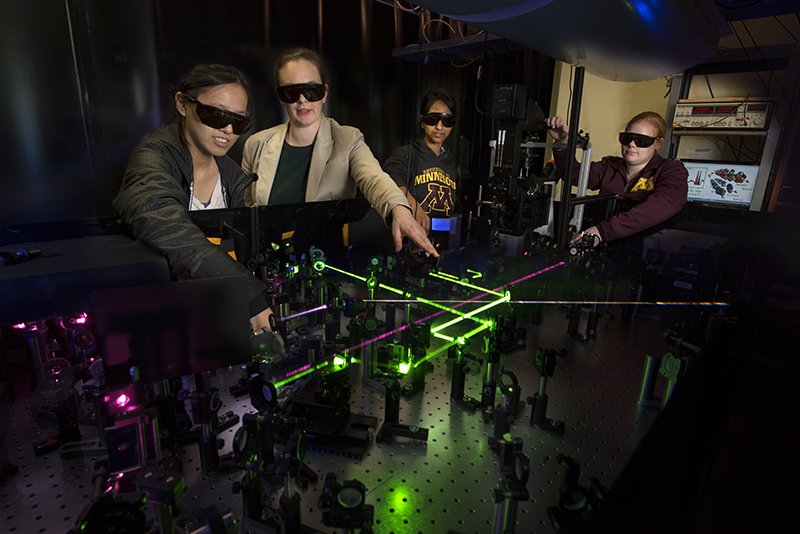Chemical Physics

Chemical Physics is an interdisciplinary graduate program with faculty from the departments of Chemistry, Physics, Chemical Engineering and Materials Science, Biochemistry, Molecular Biology and Biophysics, and Medicinal Chemistry.
Research directions of students in this program cover a range of topics, including spectroscopy, molecular collisions, chemical dynamics, quantum mechanics, statistical mechanics, thermodynamics, low-temperature behavior, nanoscience, polymers and macromolecules, surface science, and biochemical and heterogeneous catalysis.
Although it is a stand-alone degree program, students in Chemical Physics are embedded into the culture and activities of their research advisers’ home departments. Students typically take coursework and attend seminars in both chemistry and physics, and and pursue interdisciplinary research at the boundaries of chemistry, physics, materials science, and/or biology. An advantage of the Chemical Physics program is the ability to tailor one’s education and research toward research areas at the edges of traditional programs where disciplines overlap, and by being able to select relevant classes and seminars from a number of different departments.
Chemical Physics Graduate Program
Director of Graduate Studies for Chemical Physics
Professor Renee Frontiera
rrf@umn.edu
(612) 624-2501
233 Smith Hall
+
Course Requirements
What are the course requirements?
The Chemical Physics Graduate Program provides the flexibility needed for students to take courses from different departments to provide optimum preparation for their research interests, which are often interdisciplinary in nature. The program is designed to enable students with typical undergraduate backgrounds in chemistry, physics, or related subjects to begin research during the spring of their first year in residence. Course programs are individually tailored to each student, and advisers help determine research goals.
Courses
Ordinarily, course programs for doctorate students include 24 semester credits of graduate courses. Typically, each one-semester course is 4 credits, and students take about three courses per semester, so the course work requirements can, if desired, be completed during the first year. These 24-graduate credits must include either:
- at least 5 credits in chemistry and at least 5 credits in physics, or
- a total of at least 16 credits in chemistry and/or physics combined, including at least 5 credits of quantum mechanics and spectroscopy, and at least 5 credits chosen from the areas of thermodynamics, statistical mechanics, statistical physics, and chemical dynamics.
There is no minor or supporting field requirement, and no foreign language requirement. The candidacy exams may be taken in physical chemistry, physics, or chemical physics.
Seminars and colloquia
Chemical Physics students and faculty attend the department seminars and colloquia in chemistry and physics which provides twice weekly lectures by outstanding scientists from around the country and the world. In addition, Chemical Physics students present a seminar on their own research in their third and/or fourth years.
+
Financial Aid
What financial aid is available?
The Chemical Physics program offers three types of comprehensive financial support: fellowships, research assistantships, and teaching assistantships (see below). The stipends are competitive and range from about $1,800/month to $2,500/month. In addition, all graduate students who are appointed for at least half-time as research or teaching assistants receive full tuition benefits and generous health benefits.
Fellowships are awarded by the Graduate School, the Chemistry Department, or the Chemical Physics Program to highly qualified students. There are a substantial number of fellowships available for both entering students and more advanced students. Furthermore, some of our chemical physics students have received nationally competitive fellowships.
Research assistantships are funded from grant support given to faculty members for specific research projects. Major sponsors of chemical physics-related research projects are various government agencies, charitable foundations, and industry.
Teaching assistantships are awarded by the Chemistry Department. Teaching assistants supervise laboratory work, hold recitation sections, and/or grade homework assignments and exams for a total of approximately 20 hours per week.
+
Enrollment
How do I enroll?
Prospective graduate students should have adequate undergraduate preparation in chemistry, physics and mathematics, but may have majored in any subject. Students must be accepted for graduate study by the Graduate School and for financial support (in the form of a teaching assistantship or a fellowship) by the Chemistry or Physics Department, or by one of the other departments represented on our faculty. Upon their arrival at the University, new graduate students take a proficiency examination in physical chemistry, which pre-supposes knowledge equivalent to a full year study of undergraduate physical chemistry.
Current University of Minnesota doctoral students who wish to switch their degree program to Chemical Physics can do so upon approval from the Chemical Physics Graduate Committee.
To apply to the Chemical Physics Graduate Program, use the Graduate School Program Application. Specify Chemical Physics as your major area of interest. Please note that as of fall 2020 the general and subject GRE tests are not required nor considered for application to the program. If the mandatory application fee presents a significant barrier to application, please contact the Director of Graduate Studies, Professor Renee Frontiera, rrf@umn.edu, for consideration of a fee waiver.
+
Chemical Physics Faculty
Who are the Chemical Physics faculty members?
Profiles of Chemical Physics faculty
Our Chemical Physics faculty members include:
- David Blank, condensed phase, spectroscopy, and chemical dynamics
- Philippe Buhlmann, chemical sensing and imaging
- Kevin Dorfman, experimental and theoretical polymer physics
- David M. Ferguson, computational biophysics
- David Flannigan, ultrafast electron microscopy
- C. Daniel Frisbie, organic and molecular electronics
- Renee Frontiera, spectroscopy, plasmonics, super-resolution microscopy
- Jiali Gao, quantum-classical model of biology
- Allen Goldman, experimental condensed matter physics
- Jason Goodpaster, quantum theory
- J. Woods Halley, theoretical condensed-phase physics
- Christy L. Haynes, laser spectroscopy and microelectrochemistry, nanoscience
- Russ Holmes, organic and hybrid organic-inorganic semiconductor systems
- Doreen G. Leopold, photoelectron spectroscopy
- Kenneth R. Leopold, microwave spectroscopy
- Aaron Massari, polymer spectroscopy
- David Morse, statistical mechanics
- Matthew Neurock, catalysis, separations and reaction engineering
- Sapna Sarupria, molecular simulations and statistical mechanics
- J. Ilja Siepmann, statistical mechanics of condensed phases
- David Thomas, biophysical chemistry and spectroscopy
- Donald G. Truhlar, dynamics and electronic structure